ANSWER KEY -
Multiple Choice questions:
![]()
2. (b) A line segment
3. (c) Between 43° and 90°
4. (d) All the above.
5. (d) 75°
6. (b) 1
7. (a) Point of concurrence
8. (b) Intersecting lines
9. (b) 90°
10. (a) By drawing a perpendicular to a line from a point lying on it.
11. (B) 75
12. (a) diameter
13. (b) 17 cm
14. (c) 6 cm
15. (d) 11 cm
Match The Following:
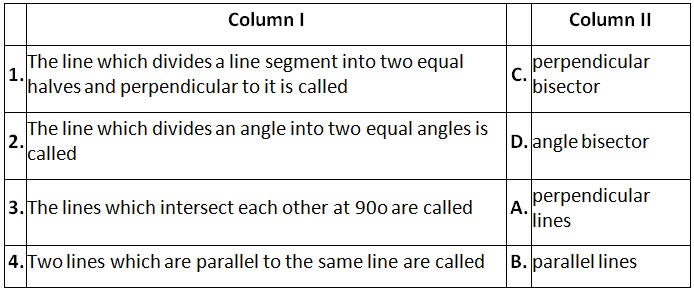
Fill in the blanks:

2. To bisect a line segment of length 5cm, the opening of the compass should be more than half of 5cm.

4. In an isosceles ∆PQR, the bisector of ∠Q and ∠R meet at O. If ∠QOR = 140°, then ∠P = 100˚.
True /False:
1. True
2. False
3. False
4. True
Very Short Answer:

2.
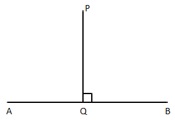
3.

Steps of Construction:
![]()
![]()
3. With x as centre and the same radius, draw another arc intersecting the first arc at y
4. Join O, Y and produce it to Q.
5. Hence, ∠POQ=60˚ is the required angle.
4.

steps:-
1. Place the zero mark of the ruler at ‘P’.
2. Mark a point ‘Q’ at a distance of 6cm from ‘P’.
3. Again mark a point ‘R’ at a distance of 4.5cm from ‘P’.
![]()
5.
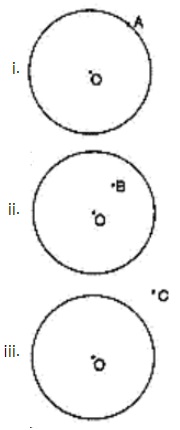
Short Answer:
1. Step I: Draw a ray OX.
Step II: With centre 0 and radius equal to the length of AB (3.6 cm) mark a point P on the ray.
![]()
Step III: With centre P and radius equal to the length of CD (1.6 cm) mark another point Q on the ray.
Thus OQ is the required segment such that OQ = 3.6 cm + 1.6 cm = 5.2 cm.
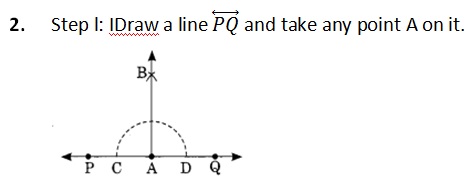
Step II: With centre A draw an arc which meets PQ at C and D.
Step III: Join AB and produce.
Step IV: With centres C and D and radius equal to half of the length of the previous arc,
draw two arcs which meets each other at B.
![]()
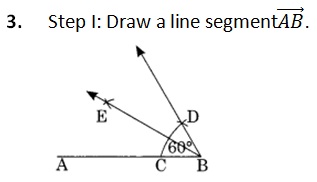
Step II: With centre B and proper radius, draw an arc which meets AB at C.
Step III: With C as centre and the same radius as in step II, draw an arc cutting the previous arc at D.
Step IV: Join B to D and produce.
Step V: Draw the bisector BE of ∠ABD.
Thus BE is the required bisector of ∠ABD.
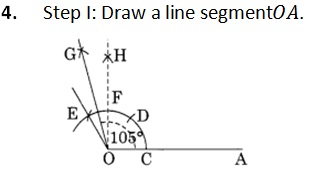
Step II: With centre O and proper radius, draw an arc which meets OA at C.
Step III: With centre C and radius same, mark D and E on the previous arc.
Step IV: Join O to E and produce.
Step V:∠EOA is the required angle of 120°.
Step VI: Construct an angle of 90° which meets the previous arc at F.
Step VII: With centre E and F and proper radius, draw two arcs which meet each other at G.
Step VIII: Join OG and produce.
Thus ∠GOA is the required angle of 105°.
5. Step I: Draw a line segment OA.
Step II: Construct ∠BOA = 90° and ∠EOA = 60°
Step III: Draw OC as the bisector of ∠BOE , which equal to

Step IV: Draw the bisector OD of ∠COA.
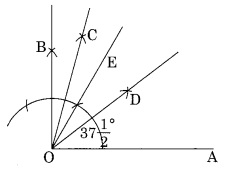
![]()
Long Answer:
1.
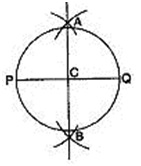

3. With the same radius and with Q as centre, draw another arc using compasses. Let it cut the previous arcs at A and B.

5. Place the pointer of the compasses at C and open the pencil upto P.
6. Turn the compasses slowly to draw the circle
2.
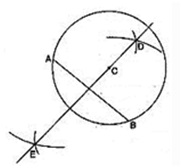
1. Draw a point with a sharp pencil and mark it as C.
2. Open the compasses for the required radius 3.4cm, by putting the pointer on 0 and opening the pencil upto 3.4cm.
3. Place the pointer of the compasses at C.
4. Turn the compasses slowly to draw the circle.

7. With the same radius and with B as centre, draw another arc using compasses. Let it cut the previous arcs at D and E.

3. Step I: Draw any ∆ABC.
Step II: Draw the perpendicular AD from A to BC.

Step III: Draw the perpendicular BE from B to AC.
Step IV: Draw the perpendicular CF from C to AB.
We observe that the perpendiculars AD, BE and CF intersect each other at P.
Thus, P is the point of intersection of the three perpendiculars.
Assertion and Reason Answers:
(1)(a)Both A and R are individually true and R is the correct explanation of A:
(2)(a)A is false but R is true.